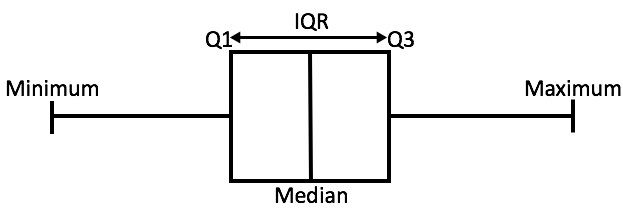All Algebra 1 Resources
Example Questions
Example Question #21 : How To Find Interquartile Range
Find the interquartile range of the following set of data:


How do you find the interquartile range?
We can find the interquartile range or IQR in four simple steps:
- Order the data from least to greatest
- Find the median
- Calculate the median of both the lower and upper half of the data
- The IQR is the difference between the upper and lower medians
Step 1: Order the data
In order to calculate the IQR, we need to begin by ordering the values of the data set from the least to the greatest. Likewise, in order to calculate the median, we need to arrange the numbers in ascending order (i.e. from the least to the greatest).
Let's sort an example data set with an odd number of values into ascending order.
Now, let's perform this task with another example data set that is comprised of an even number of values.
Rearrange into ascending order.
Step 2: Calculate the median
Next, we need to calculate the median. The median is the "center" of the data. If the data set has an odd number of data points, then the mean is the centermost number. On the other hand, if the data set has an even number of values, then we will need to take the arithmetic average of the two centermost values. We will calculate this average by adding the two numbers together and then dividing that number by two.
First, we will find the median of a set with an odd number of values. Cross out values until you find the centermost point
The median of the odd valued data set is four.
Now, let's find the mean of the data set with an even number of values. Cross out values until you find the two centermost points and then calculate the average the two values.
Find the average of the two centermost values.
The median of the even valued set is four.
Step 3: Upper and lower medians
Once we have found the median of the entire set, we can find the medians of the upper and lower portions of the data. If the data set has an odd number of values, we will omit the median or centermost value of the set. Afterwards, we will find the individual medians for the upper and lower portions of the data.
Omit the centermost value.
Find the median of the lower portion.
Calculate the average of the two values.
The median of the lower portion is
Find the median of the upper portion.
Calculate the average of the two values.
The median of the upper potion is
If the data set has an even number of values, we will use the two values used to calculate the original median to divide the data set. These values are not omitted and become the largest value of the lower data set and the lowest values of the upper data set, respectively. Afterwards, we will calculate the medians of both the upper and lower portions.
Find the median of the lower portion.
The median of the lower portion is two.
Find the median of the upper portion.
The median of the upper portion is eight.
Step 4: Calculate the difference
Last, we need to calculate the difference of the upper and lower medians by subtracting the lower median from the upper median. This value equals the IQR.
Let's find the IQR of the odd data set.
Finally, we will find the IQR of the even data set.
In order to better illustrate these values, their positions in a box plot have been labeled in the provided image.

Now that we have solved a few examples, let's use this knowledge to solve the given problem.
Solution:
Reorganize the set of data in chronological order.
Divide the set of data into four equal parts.
The first or lower quartile is:
The middle quartile is:
The third or upper quartile:
The interquartile range is the difference between the third and the first quartile.
Subtract the two numbers.
The interquartile range is 
Example Question #1981 : Algebra 1
Find the standard deviation of the following set of numbers: 
To find the standard deviation of a set of numbers, first find the mean (average) of the set of numbers:
Second, for each number in the set, subtract the mean and square the result:

Then add all of the squares together and find the mean (average) of the squares, like this:

Finally, take the square root of the second mean:

Example Question #2 : How To Find Standard Deviation
Find the standard deviation of the following set of numbers: 
To find the standard deviation of a set of numbers, first find the mean (average) of the set of numbers:

Second, for each number in the set, subtract the mean and square the result:

Then add all of the squares together and find the mean (average) of the squares, like this:

Finally, take the square root of the second mean: 
Example Question #3 : How To Find Standard Deviation
Kyle scored the following on his mathematics tests: 
To find the standard deviation of a set of numbers, first find the mean (average) of the set of numbers:
Second, for each number in the set, subtract the mean and square the result:

Then add all of the squares together and find the mean (average) of the squares, like this:

Finally, take the square root of the second mean:

Example Question #1982 : Algebra 1
Mr. Bell gave out a science test last week to six honors students. The scores were 88, 94, 80, 79, 74, and 83. What is the standard deviation of the scores? (Round to the nearest tenth.)
First, find the mean of the six numbers by adding them all together, and dividing them by six.
88 + 94 + 80 + 79 + 74 + 83 = 498
498/6 = 83
Next, find the variance by subtracting the mean from each of the given numbers and then squaring the answers.
88 – 83 = 5
52 = 25
94 – 83 = 11
112 = 121
80 – 83 = –3
–32 = 9
79 – 83 = –4
–42 = 16
74 – 83 = –9
–92 = 81
83 – 83 = 0
02 = 0
Find the average of the squared answers by adding up all of the squared answers and dividing by six.
25 + 121 + 9 +16 +81 + 0 = 252
252/6 = 42
42 is the variance.
To find the standard deviation, take the square root of the variance.
The square root of 42 is 6.481.
Example Question #1983 : Algebra 1
Give the interquartile range of a data set with the following characteristics.
Mean: 72.1
Median: 70
Standard deviation: 4.6
It cannot be determined from the information given.
It cannot be determined from the information given.
The interquartile range is the difference between the first and third quartiles. The two pieces of information needed to determine interquartile range, the first and third quartiles, are missing; therefore, it is impossible to answer the question without more information.
Example Question #3 : How To Find Standard Deviation
On his five tests for the semester, Andrew earned the following scores: 83, 75, 90, 92, and 85. What is the standard deviation of Andrew's scores? Round your answer to the nearest hundredth.
The following is the formula for standard deviation:
Here is a breakdown of what that formula is telling you to do:
1. Solve for the mean (average) of the five test scores
2. Subtract that mean from each of the five original test scores. Square each of the differences.
3. Find the mean (average) of each of these differences you found in Step 2
4. Take the square root of this final mean from #3. This is the standard deviation
Here are those steps:
1. Find the mean of the test scores:
2. Subtract the mean from each of the test scores, then square the differences:
3. Find the mean of the squared values from Step 2:
4. Take the square root of your answer from Step 3:
Example Question #3 : Standard Deviation
In her last six basketball games, Jane scored 15, 17, 12, 15, 18, and 22 points per game. What is the standard deviation of these score totals? Round your answer to the nearest tenth.
The following is the formula for standard deviation:
Here is a breakdown of what that formula is telling you to do:
1. Solve for the mean (average) of the five test scores
2. Subtract that mean from each of the five original test scores. Square each of the differences.
3. Find the mean (average) of each of these differences you found in Step 2
4. Take the square root of this final mean from #3. This is the standard deviation
Here are those steps:
1. Find the mean of her score totals:
2. Subtract the mean from each of the test scores, then square the differences:
3. Find the mean of the squared values from Step 2:
4. Take the square root of your answer from Step 3:
Example Question #1 : How To Find Standard Deviation
The variance is 
Write the formula for standard deviation in terms of variance.
Substitute the variance.
Example Question #3 : How To Find Standard Deviation
In meteorology, the standard deviation of wind speed can be used to predict the likelihood of fog forming under given temperature conditions.
What is the standard deviation of the following wind speed measurements in kilometers per hour (kph), taken 1 hour apart at the same site for 10 hours? Round to the nearest tenth.
The first step in calculating standard deviation, or 

Next, we must find the difference between each recorded value and the mean. At the same time, we will square these differences, so it does not matter whether you subtract the mean from the value or vice versa.
We use 






It's probably easier to do than to think about at first, so let's dive in!
Now, add the deviations, and we're nearly there!
Next, we must divide this number by our 
This number, 8.529, is our variance, or 

So, our standard deviation is 2.9 kph (remembering the problem told us to round to 1 decimal point.)
All Algebra 1 Resources

![[2,9,11,7,3,8,5]](https://vt-vtwa-assets.varsitytutors.com/vt-vtwa/uploads/formula_image/image/716378/gif.latex)
































![[2,9,11,7,3,8,5]\rightarrow [2,3,5,7,8,9,11]](https://vt-vtwa-assets.varsitytutors.com/vt-vtwa/uploads/formula_image/image/716379/gif.latex)

























































































